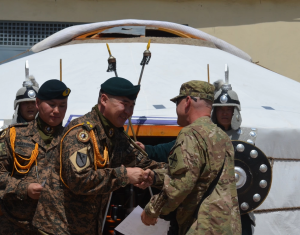The U.S. withdrawal from Afghanistan marked the end of one of the longest wars in modern history. As countries scramble to extract their military forces and civilians safely, it’s a good time to review past contributions to Afghanistan’s peace, security, and development. Mongolia, too, is one of the countries with a long history with Afghanistan and has contributed to stabilizing the war-torn country.
Afghanistan-Mongolia relations date back to the 13th and 14th centuries, when the Mongol Empire ruled Afghanistan from 1219 to 1332. One year before the Mongol invasion of the area we know today as Afghanistan, Chinggis Khan’s army reached the Caspian Sea and the Persian Gulf. In 1219, Mongol forces entered well-protected cities, annihilated their forces, and established dominance in Herat, Balkh, Ghazni, and Bamiyan. Today, we know this period as the Il-Khanate period when the Mongol Empire conquered Iran, Iraq, Azerbaijan, Armenia, Georgia, Turkmenistan, Turkey, Afghanistan, and part of Pakistan.
The modern history of Mongolia and Afghanistan, however, involves diplomacy rather than land invasion. During the 1960s, at the height of superpower competition between the United States and the Soviet Union, Mongolia sought ways to enhance its international recognition and expand its foreign policy. Given Mongolia’s geographical limitations, its relations with the Soviet Union served as a gateway to its foreign policy expansion – including establishing ties with Afghanistan. Hence, on February 1, 1962, Mongolia’s then-head of state, Marshall Tsedenbal Yumjaa went to Kabul to establish diplomatic relations with Afghanistan. While this was a sign of Mongolia’s foreign policy expansion, Ulaanbaatar and Kabul did not establish official embassies until the late 1970s.
In 1978, Shagdarsuren Puntsag was appointed as the first ambassador to Afghanistan. Two years later, in 1980, Afghanistan opened its embassy in Ulaanbaatar, and Asadullah Sarwari was sent as ambassador to Mongolia. After opening the Mongolian embassy in Kabul, then-Afghan Prime Minister Babrak Karmal first visited Mongolia in 1982. According to the existing literature on Afghanistan-Mongolia relations, given Afghanistan’s domestic political climate at the time, as Karmal’s political power grew, he banished his opponents. Sarwari was one of his opponents and was sent to Mongolia as part of his “banishment.” With no direct political or economic outcome, the Afghan Embassy in Ulaanbaatar was closed in 1988.
Although Afghanistan-Mongolia relations were never truly politically or economically motivated, the countries share historical and geographical similarities and have learned from one another.
As Afghanistan became the epicenter for the U.S.-led Global War on Terrorism, the Mongolians have returned to Afghanistan once again – not as invaders but as peacekeepers.
After joining the NATO-led International Security Assistance Force (ISAF) in Afghanistan, between 2009 to 2014, Mongolia rotated around 4,500 soldiers into Afghanistan, protecting gates and perimeters in Camp Marmal and “providing force protection in Feyzabad and flight line security at Kabul International Airport, as well as supporting the training mission in Afghanistan with infantry, artillery and air mentor trainers.” According to the First Lt. Purevdorj, the platoon leader in the 9th rotation, “the Mongolian Armed Forces, although small in numbers, were trusted by the ISAF to secure the entire base.”
Even earlier, in 2003, Mongolia and Alaska formalized their partnership under the National Guard State Partnership Program. Since 2004, Alaskan National Guard “personnel have embedded with Mongolian Armed Forces and have served alongside them in Iraq and Afghanistan.”
According to Colonel Bolor Ganbold, “between 2017-2021, 30 female soldiers have served” Mongolia’s efforts in Afghanistan.
These continued efforts illustrate Mongolia’s contribution in stabilizing Afghanistan, despite the absence of political and economic motivations. Moreover, it is important to note that Mongolia’s contribution to Afghanistan was not limited to military and security assistance.
In 2015, in cooperation with the Organization for Security and Cooperation of Europe (OSCE), Mongolia’s Ministry of Foreign Affairs successfully organized a two-week training seminar for Afghan diplomats on “Strengthening Afghanistan’s diplomatic service.” In addition, in 2018, the Afghan government ratified an agreement on establishing an International Center for Landlocked Developing Countries. At the time, then-Deputy Foreign Minister Battsetseg Batmunkh (now Mongolia’s foreign minister) thanked the Afghan ambassador to Mongolia and called for further expansion of multilateral cooperation within the center. This was a significant step in establishing Afghanistan-Mongolia intellectual and scholarly relations that would allow Mongolia to access historical documents from the Il-Khanate period.
Mongolia has continued to support both international and bilateral efforts to stabilize and develop Afghanistan. For more than a decade, the Mongolian Armed Forces, as peacekeepers, played a multidisciplinary role in safeguarding and protecting both Afghan civilians and international forces.
“The Mongolian Armed Forces in Afghanistan made a difference in range of areas,” Colonel Bolor Ganbold told The Diplomat. Mongolian troops “not only helped to train the Afghan National Army but were also involved in implementing the strengthening of its army capabilities… The Mongolian forces, although small in numbers, but our strengths are recognized and respected by the international community and the Afghanistan forces.”
Moreover, Afghanistan is home to 1 million Hazara Mongols – descendants of Chinggis Khan and his forces. After the withdrawal of U.S. and international forces, activists have been warning about the dangers facing Hazara Mongols. Previously the Mongolian government has received Hazara Mongols as international students on scholarship.
Given Afghanistan’s new domestic challenges, the two countries ought to focus on historical connections, sharing intellectual and scholarly knowledge, and learn from each other on overcoming of the difficulties of their landlocked status. As the U.S. and international forces are now leaving Afghanistan’s future in the hands of the Taliban, however, Mongolia’s contribution to and exchange with Afghanistan may be limited in the future.

































